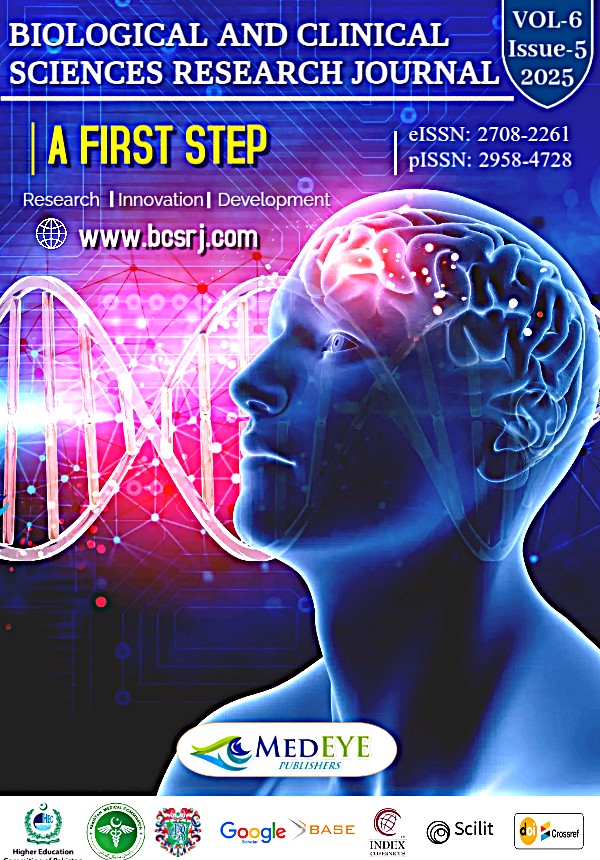Association Between Perceived Stress and Coagulation Function in Patients With Coronary Heart Disease Admitted to a Tertiary Care Hospital
DOI:
https://doi.org/10.54112/bcsrj.v6i5.1784Keywords:
Stress, Psychological Blood Coagulation Tests, Coronary Disease, Activated Partial Thromboplastin Time, Cross-Sectional StudiesAbstract
Coronary heart disease (CHD) is a major global health burden, often exacerbated by psychosocial factors such as stress. Emerging evidence suggests that perceived stress may influence coagulation parameters, potentially contributing to adverse cardiovascular outcomes. However, data from low- and middle-income countries, including Pakistan, remain limited. Objective: The objective of the study was to determine the association between perceived stress and coagulation function in patients with coronary heart disease admitted to a tertiary care hospital. Methods: It was a cross-sectional study, conducted at Shaikha Fatima Institute of Nursing and Health Sciences, Lahore, between May to December 2022. Three hundred and ten (310) patients of coronary heart disease were included in the study, a predesigned proforma containing information related to demographic characteristics, medical history, coagulation profile, and perceived stress scale. Results: 310 patients with coronary heart disease participated in our study; their mean ± SD of age, BMI, and monthly income were 52.8±14.2 years, 23.5±7.2, and 65000±20000 rupees, respectively. Among study subjects 298(96.1%) were married 189(61.0%) had sedentary occupation 198(63.8%) were diabetic, 269(86.7%) were hypertensive,112(36.1%) were smokers, obesity was observed in 98(31.6%), 34.8% were physically inactive and 129(41.6%) had family history of cardiovascular disease.. Among 310 subjects 174(56.2%) had perceived stress (score<16) and 136(43.8%) didn’t have perceived stress (score≤16). Coagulation function (APTT) was assessed; 191(61.6%) had deranged (shortened APTT, i.e., <35 sec) coagulation function, and 119(38.4%) had normal coagulation function. In our study significant association was found between perceived stress and coagulation function in patients with coronary artery disease, P=0.000. Conclusion: Perceived stress is strongly associated with PT and APTT regardless of the type of CHD. The negative impact of high perceived stress on cardiovascular prognosis could partially be explained by the activation of the intrinsic coagulation pathway.
Downloads
References
Arnett, D.K., et al. (2019).ACC/AHA Guideline on the Primary Prevention of Cardiovascular Disease: A Report of the American College of Cardiology/American Heart Association Task Force on Clinical Practice Guidelines. Circulation, 140:pp.e596–e646.
Charles, L.E., et al. (2016). Associations of work hours, job strain, and occupation with endothelial function: The Multi-Ethnic Study of Atherosclerosis (MESA). Journal of Occupation and Environment, 56, 1153–1160.
Dragano, N.; Siegrist, J.; Nyberg, S.T.; Lunau, T.; Fransson, E.I.; Alfredsson, L.; Bjorner, J.B.; Borritz, M.; Burr, H.; Erbel, R.; et al. Effort-Reward Imbalance at Work and Incident Coronary Heart Disease: A Multicohort Study of 90,164 Individuals. Epidemiology 2017, 28, 619–626.
Eledo, B.O., Izah, S.C., and Okamgba, O.C. (2018). Prothrombin Time, Activated Partial Thromboplastin Time, and Platelet Count among Hypertensive Patients Attending a Tertiary Health Institution in Yenagoa, Nigeria. Journal of Blood Research, 1(1):pp.3.
Geiser F, Urbach AS, Harbrecht U, Conrad R, Pötzsch B, Amann N. et al. Anxiety and depression in patients three months after myocardial infarction: Association with markers of coagulation and the relevance of age. J Psychosom Res. (2017) 99:162–8.
Kershaw, K.N.; Lane-Cordova, A.D.; Carnethon, M.R.; Tindle, H.A.; Liu, K. Chronic Stress and Endothelial Dysfunction: The Multi-Ethnic Study of Atherosclerosis (MESA). Am. J. Hypertens. 2017, 30, 75–80.
Komarova, Y.A.; Kruse, K.; Mehta, D.; Malik, A.B. Protein Interactions at Endothelial Junctions and Signaling Mechanisms Regulating Endothelial Permeability. Circ. Res. 2017, 120, 179–206.
Koudouovoh-Tripp, P., et al. (2021).Stress Enhances Proinflammatory Platelet Activity: the Impact of Acute and Chronic Mental Stress. Journal of Neuroimmune Pharmacology, 16:pp.500–512.
Maul, S.; Giegling, I.; Fabbri, C.; Corponi, F.; Serretti, A.; Rujescu, D. Genetics of resilience: Implications from genome-wide association studies and candidate genes of the stress response system in posttraumatic stress disorder and depression. Am. J. Med. Genet. Part B Neuropsychiatr. Genet. 2020, 183, 77–94.
Mausbach, B.T.; Chattillion, E.; Roepke, S.K.; Ziegler, M.G.; Milic, M.; von Känel, R.; Dimsdale, J.E.; Mills, P.J.; Patterson, T.L.; Allison, M.A.; et al. A longitudinal analysis of the relations among stress, depressive symptoms, leisure satisfaction, and endothelial function in caregivers. Health Psychol. 2012, 31, 433–440.
Sandrini L, Ieraci A, Amadio P, Zarà M, Barbieri SS. Impact of acute and chronic stress on thrombosis in healthy individuals and cardiovascular disease patients. Int. J Mol Sci. (2020) 21:7818.
Sandrini, L., et al.(2020).Impact of Acute and Chronic Stress on Thrombosis in Healthy Individuals and Cardiovascular Disease Patients. International Journal of Molecular Sciences, 21:pp.7818.
Sandrini, L.; Ieraci, A.; Amadio, P.; Veglia, F.; Popoli, M.; Lee, F.S.; Tremoli, E.; Barbieri, S.S. Sub-Chronic Stress Exacerbates the Pro-Thrombotic Phenotype in BDNF(Val/Met) Mice: Gene-Environment Interaction in the Modulation of Arterial Thrombosis. Int. J. Mol. Sci. 2018, 19, 3235.
Sher LD, Geddie H, Olivier L, Cairns M, Truter N, Beselaar L. et al. Chronic stress and endothelial dysfunction: mechanisms, experimental challenges, and the way ahead. Am J Physiol Heart Circ Physiol. (2020) 319:H488– 506.
Simes J, Robledo KP, White HD, Espinoza D, Stewart RA, Sullivan DR. et al. D-Dimer Predicts Long-Term Cause-Specific Mortality, Cardiovascular Events, and Cancer in Patients With Stable Coronary Heart Disease: LIPID Study. Circulation. (2018) 138:712–23.
Stewart, R.A.H.; Colquhoun, D.M.; Marschner, S.L.; Kirby, A.C.; Simes, J.; Nestel, P.J.; Glozier, N.; O’Neil, A.; Oldenburg, B.; White, H.D.; et al. Persistent psychological distress and mortality in patients with stable coronary artery disease. Heart 2017, 103, 1860–1866.
Tawakol A, Ishai A, Takx RA, Figueroa AL, Ali A, Kaiser Y, et al. Relation between resting amygdalar activity and cardiovascular events: a longitudinal and cohort study. Lancet. (2017) 389:834– 45.
Tirosh A, Lodish M, Lyssikatos C, Belyavskaya E, Feelders RA, Stratakis CA. Coagulation profile in patients with different etiologies for cushing syndrome: a prospective observational study. Hormone Metab Res. (2017) 49:365–71.
Wang JM, et al. (2022). Platelet Parameters, C - reactive protein, and Depression: An Association Study. International Journal of Genetic Medicine, 15: pp.243-251.
Yin H, Cheng X, Liang Y, Liu A, Wang H, Liu F, Guo L, Ma H and Geng Q (2021) High Perceived Stress May Shorten Activated Partial Thromboplastin Time and Lead to Worse Clinical Outcomes in Patients with Coronary Heart Disease. Front. Cardiovasc. Med. 8:769857.
Downloads
Published
How to Cite
Issue
Section
License
Copyright (c) 2025 Iram Chanda, Khalida Ibrahim, Fozia Karamat Bhatti

This work is licensed under a Creative Commons Attribution-NonCommercial 4.0 International License.








